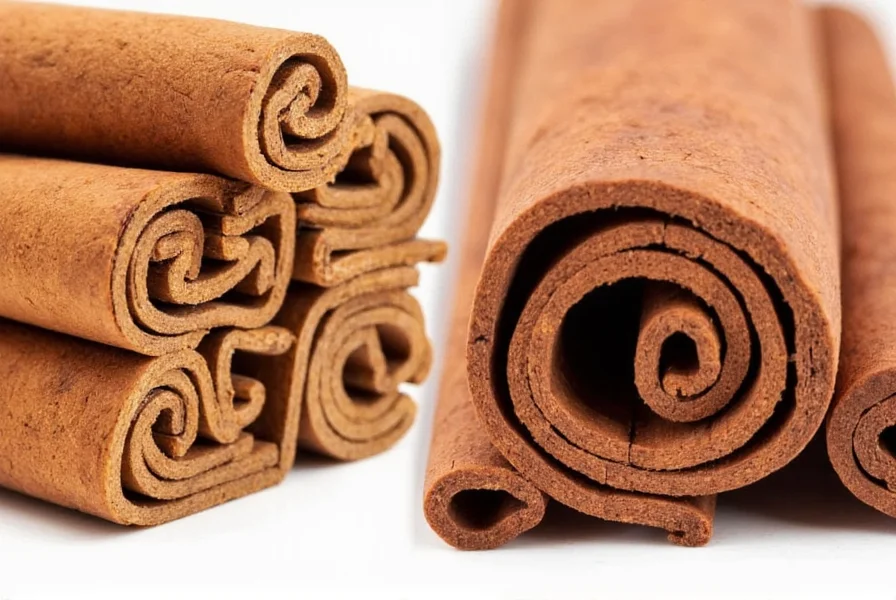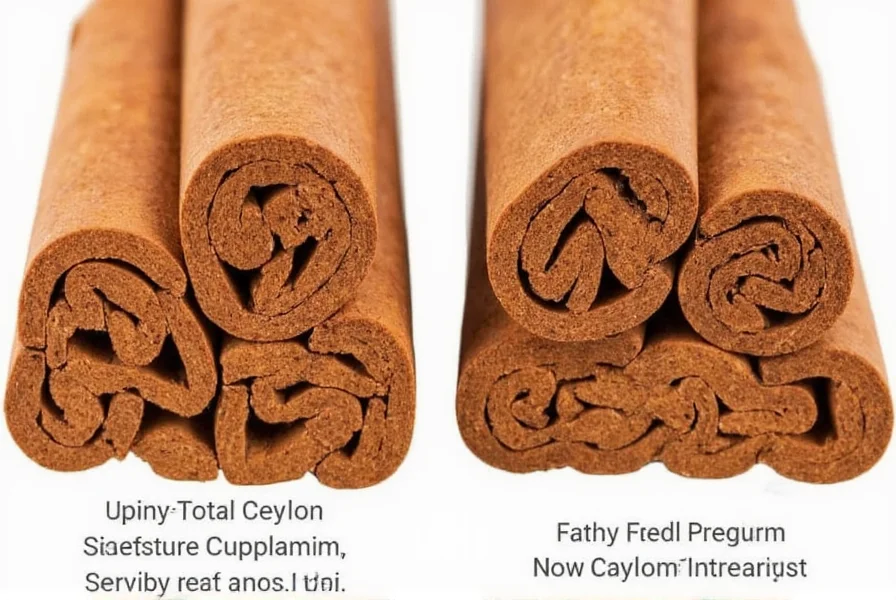Ceylon cinnamon sticks represent the authentic form of cinnamon with a centuries-old history in traditional medicine and global cuisine. These thin, tightly rolled quills form multiple delicate layers when peeled from the inner bark of Cinnamomum verum trees. The distinctive characteristic that sets Ceylon cinnamon apart from its Cassia counterpart is its complex, citrusy flavor profile and remarkably low coumarin content—typically less than 0.04% compared to Cassia's 5-10%.
Understanding the difference between Ceylon and Cassia cinnamon proves crucial for both culinary applications and health considerations. While Cassia dominates supermarket shelves due to lower production costs, Ceylon cinnamon remains the preferred choice among professional chefs and health-conscious consumers seeking the genuine article with superior safety profile.
What Makes Ceylon Cinnamon Unique
The botanical distinction between Ceylon cinnamon (Cinnamomum verum) and Cassia cinnamon (primarily Cinnamomum cassia) explains their different properties. Ceylon cinnamon grows primarily in Sri Lanka and southern India, while Cassia originates from China and Indonesia. The physical differences are immediately apparent:
| Characteristic | Ceylon Cinnamon | Cassia Cinnamon |
|---|---|---|
| Appearance | Multiple thin, delicate layers forming a soft, hollow tube | Thick, hard single卷 forming a dense, solid stick |
| Color | Light tan to pale brown | Dark reddish-brown |
| Taste | Subtle, sweet, citrusy with complex floral notes | Intense, spicy, slightly bitter |
| Coumarin Content | 0.004-0.04% | 2.5-10.0% |

Health Benefits of Ceylon Cinnamon Sticks
Research suggests several potential health benefits associated with regular consumption of Ceylon cinnamon sticks. Unlike Cassia, Ceylon's minimal coumarin content makes it suitable for daily use without liver toxicity concerns. Scientific studies indicate Ceylon cinnamon may:
- Support healthy blood sugar levels through improved insulin sensitivity
- Provide antioxidant protection against oxidative stress
- Exhibit anti-inflammatory properties that may benefit cardiovascular health
- Contain compounds with potential antimicrobial effects
A 2015 review published in the Journal of Traditional and Complementary Medicine highlighted Ceylon cinnamon's superior safety profile compared to Cassia, particularly regarding coumarin content. The European Food Safety Authority recommends limiting coumarin intake to 0.1 mg per kg of body weight daily, making Ceylon the preferred choice for regular consumption.
Culinary Uses for Ceylon Cinnamon Sticks
The delicate flavor profile of Ceylon cinnamon makes it exceptionally versatile in both sweet and savory applications. Professional chefs prefer using Ceylon cinnamon sticks in beverages because they infuse smoothly without overpowering other flavors. Some exceptional applications include:
- Infusing in hot beverages like chai, coffee, or hot chocolate
- Adding to rice pudding, custards, and other delicate desserts
- Enhancing fruit compotes and poached fruits
- Creating aromatic broths for seafood or poultry dishes
- Flavoring syrups for cocktails and mocktails
When substituting Ceylon cinnamon sticks for powder, remember that one 2-3 inch stick equals approximately 1 teaspoon of ground cinnamon. For optimal flavor extraction, gently crush sticks before use to increase surface area.
How to Identify Authentic Ceylon Cinnamon
With increasing demand for genuine Ceylon cinnamon, mislabeling has become common. Follow these guidelines when shopping for authentic Ceylon cinnamon sticks:
- Examine the structure: Genuine Ceylon sticks consist of multiple thin layers that appear almost papery
- Check the color: Should be light tan rather than dark reddish-brown
- Test the texture: Should crumble easily when bent, not snap like Cassia
- Smell the aroma: Should have a sweet, citrusy fragrance rather than intense spice
- Verify origin: Authentic Ceylon cinnamon should specify Sri Lanka (formerly Ceylon) as origin

Storage Recommendations
To preserve the delicate flavor compounds in Ceylon cinnamon sticks, proper storage proves essential. Store in an airtight container away from light, heat, and moisture. When stored correctly, Ceylon cinnamon sticks maintain optimal flavor for 1-2 years, significantly longer than ground cinnamon. Avoid refrigeration, which can introduce moisture that degrades quality.
Safety Considerations
While Ceylon cinnamon offers a safer profile than Cassia, moderation remains important. The acceptable daily intake of coumarin is approximately 0.07 mg per pound (0.1 mg per kg) of body weight. With Ceylon cinnamon containing only trace amounts of coumarin, consuming 1-2 sticks daily generally falls within safe limits for most adults. However, individuals with liver conditions should consult healthcare providers before regular consumption.
Conclusion
Ceylon cinnamon sticks represent the premium choice for discerning cooks and health-conscious consumers seeking authentic flavor with minimal health concerns. Their distinctive layered structure, delicate flavor profile, and superior safety characteristics make them worth seeking out despite typically higher cost than Cassia varieties. By understanding how to identify genuine Ceylon cinnamon and incorporating it properly into culinary creations, you can enjoy both its exquisite flavor and potential health benefits safely.
Frequently Asked Questions
What's the main difference between Ceylon and Cassia cinnamon sticks?
Ceylon cinnamon sticks feature multiple thin, delicate layers forming a soft, hollow tube with a light tan color and subtle, citrusy flavor. Cassia cinnamon forms thick, hard single卷 with dark reddish-brown color and intense, spicy flavor. Most importantly, Ceylon contains significantly lower coumarin levels (0.004-0.04%) compared to Cassia (2.5-10.0%), making it safer for regular consumption.
Can I use Ceylon cinnamon sticks every day?
Yes, Ceylon cinnamon sticks can be safely consumed daily due to their minimal coumarin content. Most experts consider 1-2 inches of Ceylon cinnamon stick daily (approximately 0.5-1 gram) safe for regular consumption. This contrasts with Cassia cinnamon, which should be limited to occasional use because of its high coumarin levels that may cause liver toxicity with regular consumption.
How do I substitute Ceylon cinnamon sticks for powder in recipes?
One 2-3 inch Ceylon cinnamon stick equals approximately 1 teaspoon of ground cinnamon. For best results when substituting, gently crush the stick before adding to your recipe to increase surface area and improve flavor extraction. Remember that Ceylon has a more delicate flavor than Cassia, so you may need slightly more for equivalent flavor intensity in some applications.
Why is Ceylon cinnamon more expensive than regular cinnamon?
Ceylon cinnamon commands a higher price due to several factors: it comes from a specific tree species (Cinnamomum verum) primarily grown in Sri Lanka, requires more labor-intensive harvesting methods, produces less yield per tree, and has higher global demand than supply. The multi-layered quills require careful peeling by skilled workers, and the trees take several years to mature before harvesting can begin, contributing to the premium cost.











 浙公网安备
33010002000092号
浙公网安备
33010002000092号 浙B2-20120091-4
浙B2-20120091-4